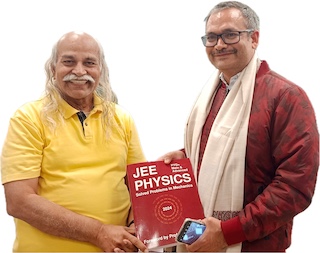Wheatstone bridge
A balanced Wheatstone bridge is very useful in analysing electrical circuits. The bridge is formed by five resistors of resistances \(R_1\), \(R_2\), \(R_3\), \(R_4\) and \(R_5\). The circuit is balanced when \(R_1/R_2=R_3/R_4\). In this case, the potential at points C and D are equal and no current flows through the resistor \(R_5\). Generally, a galvanometer is connected in place of \(R_5\).
You need two bulbs of 100 watt, two bulbs of 60 watt, one bulb of 10 watt, five bulb holders and connecting wires.
Procedure
In this demonstration, a Wheatstone bridge is constructed using light bulbs. Connect five bulb holders to make the circuit shown in the figure.
Plug two 100 watt bulbs in holder \(\mathrm{B_1}\) and \(\mathrm{B_4}\), two 60 watt bulbs in holder \(\mathrm{B_2}\) and \(\mathrm{B_3}\), and 10 watt bulb in holder \(\mathrm{B_5}\). Connect the circuit to 220 V power supply. All the bulb starts glowing. Now, interchange the bulbs in \(\mathrm{B_1}\) and \(\mathrm{B_3}\). When plugged in, the four outer bulbs light while the central bulb doesn't. Try different combinations of the bulbs and holder and analyse the results. The same setup may be used to study series and parallel combinations of bulb. This is a good demo to eliminate misconception regarding \(P={V^2}/{R}\) and/or \(P=i^2R\).
Hazard: Be careful when working with 220 V AC supply. It may be fatal.
Discussion
The resistance \(R\) of the bulb is inversely proportional to its power \(P\) i.e., \(R=V^2/P\). Ask the students to calculate resistances of various bulbs and check Wheatstone bridge `balance condition' for various combinations.
Problem from IIT JEE
Problem (JEE Mains 2019): The Wheatstone bridge shown in the figure gets balanced when the carbon resistor used as $R_1$ has the colour code (Orange, Red, Brown). The resistors $R_2$ and $R_4$ are 80 ohm and 40 ohm respectively. Assuming that the colour code for the carbon resistors gives their accurate values, the colour code for the carbon resistor, used as $R_3$, would be
- Brown, Blue, Brown
- Brown, Blue, Black
- Red, Green, Brown
- Grey, Black, Brown
Solution: The colour code values in carbon resistors are: B(0), B(1), R(2), O(3), Y(4), G(5), B(6), V(7), G(8), W(9).
The resistance of a resistor with colour code (Orange-3, Red-2, Brown-1) is, \begin{align} R_1&=32\times{10}^{1} \\ &=320\;\Omega.\nonumber \end{align} The Wheatstone bridge is balanced when $R_1/R_2=R_3/R_4$ i.e., \begin{align} R_3&=\frac{R_1 R_4}{R_2} \\ &=\frac{(320)(40)}{80}\\ &=160 \\ &=16\times{10}^{1}\;\Omega.\nonumber \end{align} The first digit is 1 (Brown), the second digit is 6 (Blue), and the power of 10 is 1 (Brown). Thus, the colour code for $R_3$ is (Brown, Blue, Brown).Related
- Colour code for resistors
- Series and Parallel Arrangements of Resistances
- Specific resistance of the material of a wire using meter bridge and post office box
- Kirchhoff's Laws
- NAEST Question (with Solution)
Subscribe to our channel
